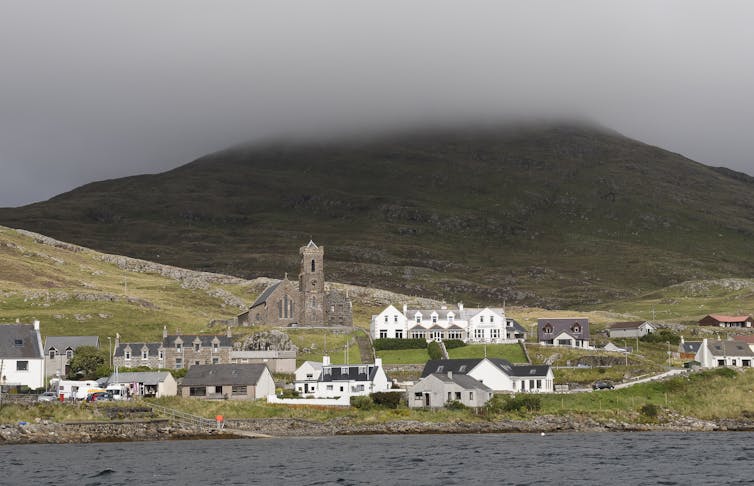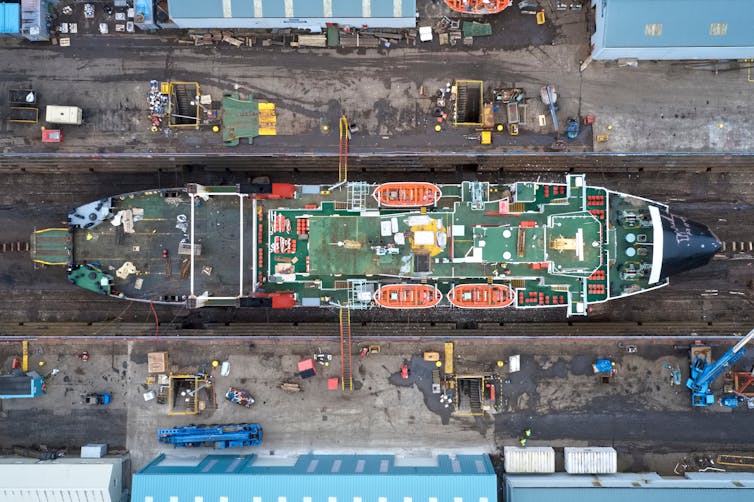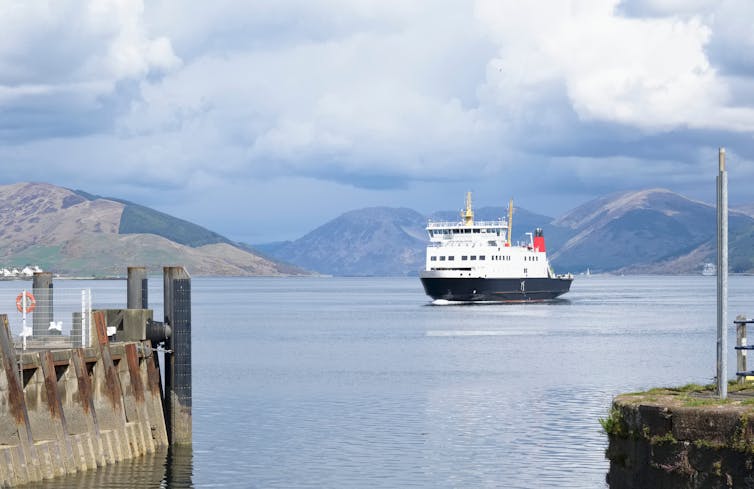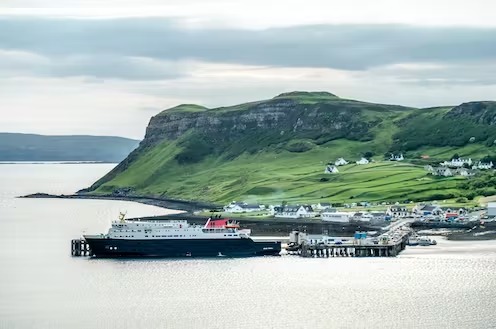Scottish ferry operator CalMac cancelled all direct sailings from the mainland to South Uist, the second largest island in the Outer Hebrides, off the north-west coast of Scotland on June 1 2023. Cancellations are expected to last until June 30.
Disruption to ferry services to Scottish islands has been a long-term problem. One local business leader has claimed the economic impact is worse than that of COVID lockdowns.
In October 2022, 72% of sailings on the South Uist route were cancelled, followed by only four on time sailings in November. And in the first four months of 2023, the cancellation rates were 43%, 63%, 21% and 65% respectively.
On June 6 2023, transport minister Kevin Stewart, who had only been in office for two months, resigned. His departure leaves islanders once again lacking any consistent support with the ferry issues. Resolving this is a major challenge for the new first minister, Humza Yousaf.
At first minister’s questions on June 8 2023, Scottish Conservative leader Douglas Ross said the failures of the government were “ruining lives, damaging businesses, costing jobs and driving islanders to despair”.

Castlebay on Barra, with cloud descending over the hill of Heaval. MichaelY/Shutterstock
According to the Scottish government’s 2019 national islands plan, the Scottish isles define how people across the world see Scotland and “contribute hugely to our national identity while also preserving and promoting strong local identities”.
Yet, the SNP government has allowed the island ferry network to reach a crisis point leaving islanders disconnected and isolated from the mainland. This raises the question of why intervention hasn’t happened earlier.
What went wrong
CalMac, which is owned by the Scottish government, is the only ferry operator in the Outer Hebrides. The company has cited ageing vessels as the root cause of the ongoing disruptions.
Six out of ten of CalMac’s major vessels are either approaching or beyond their operational life. In May 2022, the company reported an increase of 67% in their maintenance budget between 2017 and 2022.
Despite this ageing fleet, no new ferries have been launched since Nicola Sturgeon became first minister in November 2014. In 2015, Sturgeon’s government ordered two ferries from the shipbuilding company Ferguson Marine, but that decision has been an ongoing controversy.
In December 2019, the company was nationalised by the Scottish government, after going into administration, with debts of over £73 million. The two new ferries, which had been due to enter service in 2018 and were reportedly at the centre of the company’s financial collapse, remained only partially built.
Five years on, these vessels – christened the Glen Sannox and the Hull 802 – are still not ready. The estimated costs to see them launched are now quadruple the original £97 million budget.

Two new ferries have been under construction for five years. Richard Johnson/Shutterstock
Financial mismanagement
The Scottish government awarding this contract to Ferguson Marine was controversial to begin with. The decision is still under scrutiny by Audit Scotland, the public spending watchdog.
In its March 2022 report, the watchdog found that in 2015, the CalMac board “had considered there were too many risks involved to award the contract”. Despite these warnings, the Scottish government had chosen to proceed with the deal.
The Scottish government also chose not to take action, in 2018, when they were warned – by their advisors, the consulting firm PwC – of the financial implications of the issues with Ferguson Marine.
In addition to the delays, these two new ferries have already cost CalMac £1.6 million in crew costs, despite not yet having set sail. On just one of the vessels, 14 staff have been recruited, including three masters, three chief engineers, three second engineers, and five third engineers.
Island businesses, particularly in Uist and Barra, rely heavily on tourism and exporting their products, but this latest announcement has left them in a vulnerable position. This only adds to the cost-of-living crisis and the lasting impact of the pandemic. Many are now left asking whether living on these remote islands remains viable.

Young people are leaving, priced out of the Hebridean housing market. Richard Johnson/Shutterstock
Depopulation, particularly in the working-age groups, has long been an issue for Scotland’s islands. Not having a reliable link to the mainland only compounds this problem.
Over one in four people (27%) in the Outer Hebrides are aged 65 or over, compared with the Scottish average of 20%. Between 2001 and 2021, the 25-44 age group saw a 21.4% decrease in numbers.
Many young islanders move to the mainland for university and do not return due to a lack of jobs and opportunities. Meanwhile, young people are being priced out of the local housing market. Compared with the Scottish average of 9.7%, between 2021 and 2022, house prices in the Outer Hebrides have risen by 27.7%.
Local islanders cannot compete with people buying second homes. In Barra and Vatersay, more than one in ten (13.4%) of houses are now second homes. Limited housing combined with rising living costs therefore already make these islands a more challenging place to live.
Resolving the ferry crisis ought to be a top priority within the government’s National Islands plan, the stated aim of which is to “meaningfully improve outcomes for island communities”. But until new ferries materialise, there is very little comfort in first minister Yousaf’s reassurances of his government’s commitment to do so.



 SpaceX Begins IPO Preparations as Wall Street Banks Line Up for Advisory Roles
SpaceX Begins IPO Preparations as Wall Street Banks Line Up for Advisory Roles  EU Signals Major Shift on 2035 Combustion Engine Ban Amid Auto Industry Pressure
EU Signals Major Shift on 2035 Combustion Engine Ban Amid Auto Industry Pressure  Woolworths Faces Fresh Class Action Over Alleged Underpayments, Shares Slide
Woolworths Faces Fresh Class Action Over Alleged Underpayments, Shares Slide  Treasury Wine Estates Shares Plunge on Earnings Warning Amid U.S. and China Weakness
Treasury Wine Estates Shares Plunge on Earnings Warning Amid U.S. and China Weakness  Korea Zinc to Build $7.4 Billion Critical Minerals Refinery in Tennessee With U.S. Government Backing
Korea Zinc to Build $7.4 Billion Critical Minerals Refinery in Tennessee With U.S. Government Backing  Nvidia Weighs Expanding H200 AI Chip Production as China Demand Surges
Nvidia Weighs Expanding H200 AI Chip Production as China Demand Surges  Robinhood Expands Sports Event Contracts With Player Performance Wagers
Robinhood Expands Sports Event Contracts With Player Performance Wagers  Strategy Retains Nasdaq 100 Spot Amid Growing Scrutiny of Bitcoin Treasury Model
Strategy Retains Nasdaq 100 Spot Amid Growing Scrutiny of Bitcoin Treasury Model  Fortescue Expands Copper Portfolio With Full Takeover of Alta Copper
Fortescue Expands Copper Portfolio With Full Takeover of Alta Copper  Apple Explores India for iPhone Chip Assembly as Manufacturing Push Accelerates
Apple Explores India for iPhone Chip Assembly as Manufacturing Push Accelerates  FDA Says No Black Box Warning Planned for COVID-19 Vaccines Despite Safety Debate
FDA Says No Black Box Warning Planned for COVID-19 Vaccines Despite Safety Debate  noyb Files GDPR Complaints Against TikTok, Grindr, and AppsFlyer Over Alleged Illegal Data Tracking.
noyb Files GDPR Complaints Against TikTok, Grindr, and AppsFlyer Over Alleged Illegal Data Tracking.  FAA Unveils Flight Plan 2026 to Strengthen Aviation Safety and Workforce Development
FAA Unveils Flight Plan 2026 to Strengthen Aviation Safety and Workforce Development  California Jury Awards $40 Million in Johnson & Johnson Talc Cancer Lawsuit
California Jury Awards $40 Million in Johnson & Johnson Talc Cancer Lawsuit  MetaX IPO Soars as China’s AI Chip Stocks Ignite Investor Frenzy
MetaX IPO Soars as China’s AI Chip Stocks Ignite Investor Frenzy  Korea Zinc Plans $6.78 Billion U.S. Smelter Investment With Government Partnership
Korea Zinc Plans $6.78 Billion U.S. Smelter Investment With Government Partnership 
































